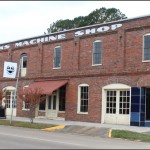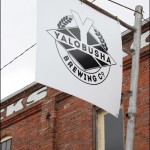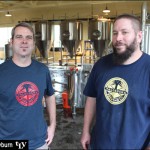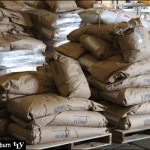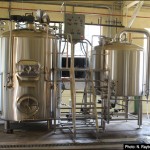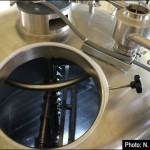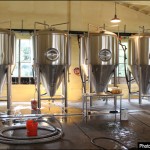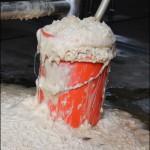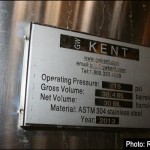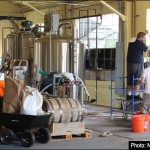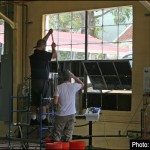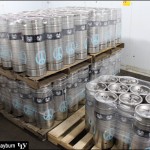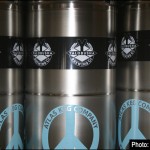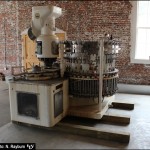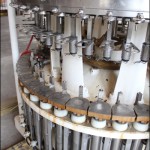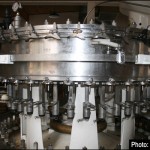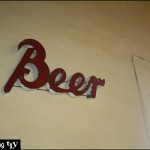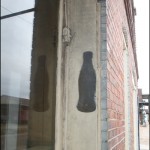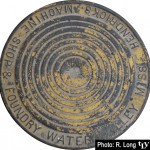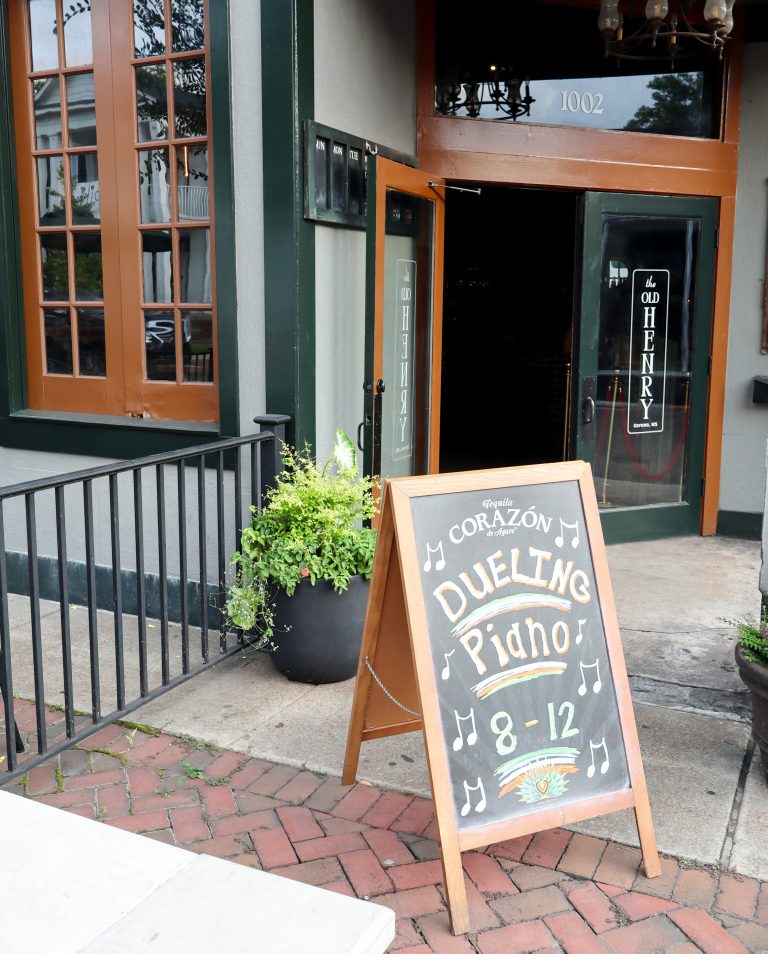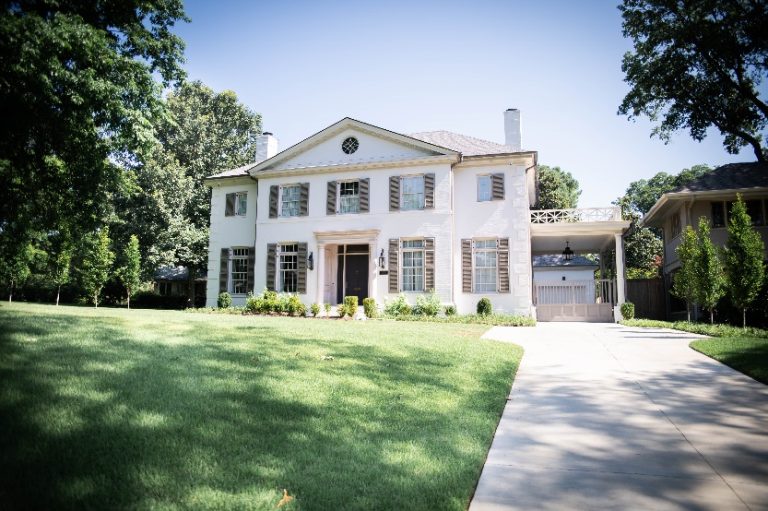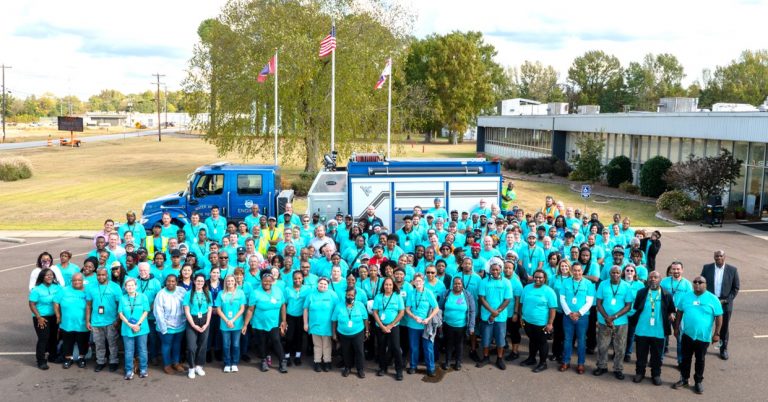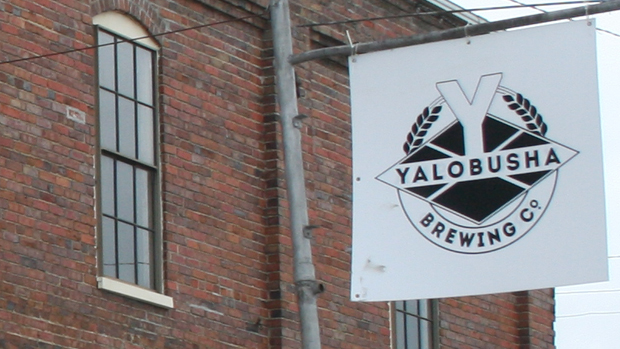
Intro by Rebecca Long
Interview (below) & photos by Newt Rayburn & Rebecca Long
–
Yalobusha Brewing Company is open for business on Main Street in Water Valley, Mississippi! They’ve been brewing up beer since the beginning of October 2013. Recently Newt Rayburn and I had the opportunity to take a thorough tour and to interview owner Andy O’Bryan and master brewers Tony Balzola and Amos Harvey.
 The tour began with Harvey showing us through the brewing process, explaining the function of each machine and specifics on the methods they use for Yalobusha Brewing Company’s suds selections. We were shown the mash tub first because that’s where brewing begins – it mixes grain evenly with 172° water and then the mixture goes through a steeping process called conversion for about 45 minutes to create simple sugars by pushing the starches out of the grain. After conversion the mixture is known as wort; valves are used to recirculate the wort through the grain bed – a process called vorlauf, from its German roots. Vorlauf is, Harvey says, “To clear up the beer and to make it kind of an even mash.” The mixture is sent over to the kettle after it’s been mixed for about 15 minutes, where steam jackets are used to heat it up. “About thirty minutes before the end of the boil,” Harvey explains, “We start adding more hops, and more hops. It boils for ninety minutes, and when you add the hops at the beginning, it’s more for in-your-mouth bittering. And as the hops get added towards the end of the boil, it’s more for aroma. So it doesn’t end as bitter but when you put the beer to your nose – when you smell the hops in the beer – it’s because we’ve added them really close to the end of the boil.” Once the beer is boiled for ninety minutes, it’s whirlpooled for about twenty minutes with a set of valves to suck all the hops into a cone in the middle of the kettle. And then the wort is cooled before moving it to one of the fermentation tanks. It has to be cooled because, Harvey says, “If it’s too hot it’s going to burn the yeast, or mutate it and hurt it, so we need to have it at 70 degrees.”
The tour began with Harvey showing us through the brewing process, explaining the function of each machine and specifics on the methods they use for Yalobusha Brewing Company’s suds selections. We were shown the mash tub first because that’s where brewing begins – it mixes grain evenly with 172° water and then the mixture goes through a steeping process called conversion for about 45 minutes to create simple sugars by pushing the starches out of the grain. After conversion the mixture is known as wort; valves are used to recirculate the wort through the grain bed – a process called vorlauf, from its German roots. Vorlauf is, Harvey says, “To clear up the beer and to make it kind of an even mash.” The mixture is sent over to the kettle after it’s been mixed for about 15 minutes, where steam jackets are used to heat it up. “About thirty minutes before the end of the boil,” Harvey explains, “We start adding more hops, and more hops. It boils for ninety minutes, and when you add the hops at the beginning, it’s more for in-your-mouth bittering. And as the hops get added towards the end of the boil, it’s more for aroma. So it doesn’t end as bitter but when you put the beer to your nose – when you smell the hops in the beer – it’s because we’ve added them really close to the end of the boil.” Once the beer is boiled for ninety minutes, it’s whirlpooled for about twenty minutes with a set of valves to suck all the hops into a cone in the middle of the kettle. And then the wort is cooled before moving it to one of the fermentation tanks. It has to be cooled because, Harvey says, “If it’s too hot it’s going to burn the yeast, or mutate it and hurt it, so we need to have it at 70 degrees.”
The fermentation tanks, of  which Yalobusha has four currently, each hold about 900 gallons of brew. “That’s 30 barrels, and the way we sell our kegs is by the sixth barrel, so that’s close to 180 sixth barrels per 30 barrel batch,” explains Harvey. It takes three to five days to ferment the beers they’ve decided to brew. The tanks have a vapor lock; carbon dioxide bubbles out as the yeast eats simple sugars to produce this gas along with alcohol. “It’s messy,” says Harvey, “but we’re happy when we see the mess because it means it’s doing its thing.” Towards the end of the fermentation process, when the bubbling calms down, they “Cap it off, close it, and then it starts creating its own pressure. Because the more natural CO2 in the beer, the better and softer the carbonation is. And we’ll start seeing the pressure build a little bit here (taps pressure gauge), and we’ll cap it for about two days so it can kind of carbonate itself. We check it the next day and if there’s no real change, we’ll do what’s called crashing it. These tanks are jacketed, and they can be cooled; we’ll set the temperature down to like 35 degrees, and it helps all the yeast drop out of suspension, and that starts clearing up the beer, and it makes the yeast go dormant.” After the beer has crashed for a few days, it’s moved to a different tank without the yeast using carbon dioxide and gravity because, Harvey says, they “don’t want to beat up the beer, run it through a pump or aerate it.” After being moved to the break tank, they “Put CO2 on it, to finish out the carbonation, because you rarely get all your beer carbonated naturally.”
which Yalobusha has four currently, each hold about 900 gallons of brew. “That’s 30 barrels, and the way we sell our kegs is by the sixth barrel, so that’s close to 180 sixth barrels per 30 barrel batch,” explains Harvey. It takes three to five days to ferment the beers they’ve decided to brew. The tanks have a vapor lock; carbon dioxide bubbles out as the yeast eats simple sugars to produce this gas along with alcohol. “It’s messy,” says Harvey, “but we’re happy when we see the mess because it means it’s doing its thing.” Towards the end of the fermentation process, when the bubbling calms down, they “Cap it off, close it, and then it starts creating its own pressure. Because the more natural CO2 in the beer, the better and softer the carbonation is. And we’ll start seeing the pressure build a little bit here (taps pressure gauge), and we’ll cap it for about two days so it can kind of carbonate itself. We check it the next day and if there’s no real change, we’ll do what’s called crashing it. These tanks are jacketed, and they can be cooled; we’ll set the temperature down to like 35 degrees, and it helps all the yeast drop out of suspension, and that starts clearing up the beer, and it makes the yeast go dormant.” After the beer has crashed for a few days, it’s moved to a different tank without the yeast using carbon dioxide and gravity because, Harvey says, they “don’t want to beat up the beer, run it through a pump or aerate it.” After being moved to the break tank, they “Put CO2 on it, to finish out the carbonation, because you rarely get all your beer carbonated naturally.”
When we asked about what the other tanks contained Harvey said, “Everything’s full. It’s actually a pretty good feeling.” As of the day we visited the brewery, River Ale was the only variety being offered, but they have an I.P.A. coming out next (as soon as they get green-lighted by the state), followed by an amber brew. They’re also using their smaller “pilot system” to produce a milk stout at the moment – the first of many bourbon barrel aged brews to come.
Right now, their distribution is limited to North Mississippi – including Oxford, Tupelo, West Point, Southaven, and Senatobia…even Starkville. The next step is to get a distributor for central and Southern Mississippi. Harvey explains, “Nobody in Mississippi has a refrigerated truck.” When asked why, his simple answer was, “They never had to.” Lazy Magnolia was the first brewery to open in Mississippi – in 2003 – located in a town called Kiln in the southernmost part of the state. The Mississippi Brewers Guild recently produced a brochure illustrating all the breweries across the state – a total of eight locations now. But O’Bryan explained that the “established on” dates on the remaining seven breweries are all in 2012 – they’ve all begun in the last eighteen months.
Tours will start soon (stay updated at facebook.com/YalobushaBrewing), but with the current law Harvey says, “We can’t sell beer here, at our place. Eventually we’ll have a tap running, here in the central area. And when we do tours, you can have six 6oz. samplers, or one 36oz. sampler, or however you want to break it up. In most everybody’s mind, the next logical step is, ‘Hey, I’d like to buy a couple of cases of beer. Thanks for the tour.’” He says Mississippi’s Raise Your Pints plans on “trying to make legislation to let breweries sell just a small amount [of beer], and all the distributors are going to lobby against it.” The three-tier distribution system existing in most states is prohibitive in some ways, like disallowing family members of brewery owners from having retail or distribution licenses. But at the same time, O’Bryan sees a lot of merit in the system – “It’s not all bad. [Without the three-tier system] we’d have a very small brewery with a very small service area. But because of the three-tier system I can build a brewery that’s three times larger and we can focus 100% on making the best beer possible.”
 When Newt mentioned out that Coca-Cola was first bottled in Vicksburg, Mississippi, Harvey pointed out that in the past there have been two bottling plants located in Water Valley. He said, “There was a Coca-Cola plant, and there was a Double Cola plant, right next to each other, right across from SprintMart. That’s kind of neat, and we’re kind of digging around, asking people if they have any old Double Cola memorabilia.”
When Newt mentioned out that Coca-Cola was first bottled in Vicksburg, Mississippi, Harvey pointed out that in the past there have been two bottling plants located in Water Valley. He said, “There was a Coca-Cola plant, and there was a Double Cola plant, right next to each other, right across from SprintMart. That’s kind of neat, and we’re kind of digging around, asking people if they have any old Double Cola memorabilia.”
The place was spotless when we arrived but got a little messy by the time we were done. We commented on the amount of cleaning their crew has to do, and Harvey answered, “Brewing is 99% sanitation, really. And when we do a batch, like when we did that amber, that’s a fifteen barrel system, but our fermentation tanks are thirty barrels, so we basically have to brew twice to fill those up. So our brew day is 6 am to midnight. There’s some monitoring in between, so it’s not hard labor all that time, but we get done about 9:00, and it takes three hours to clean up.” O’Bryan said, “We’ll eventually be milling our grain – we’ve already got the mill, we just have to build another building out back. It’s a factory, that’s the bottom line. A lot of people don’t realize it – when the tours start, people’s minds will really be opened as far as how much work goes into it. A picture’s worth a thousand words. Go back there and look – it’s hard work. But at the end of the day, we’re making beer, man! This is a good thing. All walks of life can get into it. It’s very accessible, very affordable. It’s not highbrow in the least – you can make it that way, and decide to be a beer collector, but even these products in the grand scheme of things when compared to wine bourbon, it’s more of a blue-collar type of thing. It’s like a Bruce Springsteen song down here in Water Valley.”
Where did you learn to brew?
Harvey: In the mid-nineties I went out West, headed to Portland, Oregon, but found a job in Boise, Idaho brewing and started assistant brewing at a brewhouse there called Big Horn Brewing Company. And then I came back to Mississippi waiting for the law to change, with the knowledge to brew, and the law didn’t change. So I went to Abita and brewed [there] for another year. Then I got sucked back up into the music industry for the last fifteen years.
How long were you at Abita?
Harvey: A little over a year at each place, because I just kept waiting for the law to change. One year passed, time to vote, didn’t go through, go off to Abita. Another year passed and the law didn’t change, but I stayed at Abita for a little while, and Mac and Bruce signed with Epitaph during that time, and I got dragged away from [brewing].
You help Amos come up with all the new recipes and with brewing?
Balzola: Yeah, we’re a team. I’m definitely more on the recipe design side and he’s more on the brewery operation side, but we come together on everything. I’ve got a little more experience designing recipes than he does.
Where have you worked?
Balzola: All my brewing was done for this company called McMenamins in Portland, Oregon and they run a bunch of brewpubs – you won’t find them in bottles unless you buy it at their locations. They have dozens of different small breweries that supply all their little places, and there’s a lot of creative freedom to make your own recipes, and you’re making twelve keg batches so it’s a lot smaller in scale than this. I worked for them right out of college – I didn’t start brewing for them until a few years in, but was with them for sixteen years when I left. They’re a great company, but I’d reached as far as I could go with them, just being a brewer.
Why did you decide to open up a brewery?
O’Bryan: Well, I started looking at it a couple of years ago. I had a restaurant down in Carroll County, and then I started looking in Greenwood to build another restaurant, and I started looking up here to do one. I was wanting to do a brewpub, and I did all this research not even knowing that wasn’t even possible. I just had to abandon all this research. But at the end of last year, I decided to pick up the research again but decided to just look at production breweries. I started traveling around, and – it sounds like a big number – I think it was either 41 or 42 breweries I went to in the last two years, but that’s not 42 cities. I went to 20 breweries just in Chicago over a two week period. It was really incredible going to these places. Like, when I went to Revolution in Chicago – those guys don’t know me – but I sent them an email with my name and told them I was researching to start a brewery in Mississippi and I wanted to pick their brains, and they said, “Ok, you’re now an employee for a day – all access – what do you want?” The industry as a whole is really incredible as far as sharing resources. It’s a hundred billion dollar industry in the United States, and all of the craft breweries combined are only 8-9% of the hundred billion – all of them. So 91 billion dollars is Miller, Coors, and Budweiser, and they’re all owned overseas now. And 3,000 craft breweries are the other 9%, so it is us against them. The American breweries are combining resources, basically, and helping each other out, and sharing grain orders, and the cost of glassware, so it’s really amazing.
 Why did you pick Water Valley rather than Oxford?
Why did you pick Water Valley rather than Oxford?
O’Bryan: This building. Period. This building doesn’t exist in Oxford.
Harvey: This could have been a warehouse on the side of the highway, in Oxford. It would have been a metal building and a slab and no character.
O’Bryan: The building was perfect.
Harvey: It was made for this. When I moved here in 2004 and took a turn up this hill to go look at a house, I saw this building and knew I wanted to brew here someday.
What was this building before?
Harvey: It was Hendricks Machine Shop and Foundry, at first, in the late 1800s. You’ll see around town some of the manholes – they made those. They worked on tractors and train parts and things, and in the 40s is when they brought this part of the building over, I think this was from Camp Shelby. I think they turned this into a Ford dealership, so they used to work on cars back here.
O’Bryan: In March – our friend told me [Amos] worked at Abita; I asked what he did there and he told me he was a brewer. I thought he was completely messing with me. And I said, “Well, do you have his number?” And he said, “He runs Lamar Lounge.” And he described him and I recognized the description. So my wife and I went and sat at the bar and ordered some food, and I motioned and told Amos I wanted to holler at him; he went and checked on something and came over there, and I introduced myself and I said, “I’m going to tell you something that three people know besides me. I’m trying to keep it quiet but I’m going to tell you about it.” And he’s thinking: ‘There’s this completely random guy who’s come in my bar, kissing my earlobe, telling me a secret – who is this freak?’ And I said, “I’m about to open a brewery in Oxford, Mississippi.” And his whole demeanor just changed. I just went over there to talk to him, I had no idea he would have left what he was doing to come work with me. But obviously that was his passion, that’s what he wanted to do, and it was just perfect timing. Once we got to speed and we realized we wanted to work together he said, “Don’t buy a building in Oxford before you see this building in Water Valley.” A couple of weeks later we got down here and we realized very quickly that this is a special building. What we didn’t know at the time was what we had to do to the building to make it ready. And what really interested us, sold us, as far as buying the building was we found that the only thing we had to do was cut new floor drains – that’s it. Otherwise, we’ve done nothing to the building. And don’t have any plans to change the building, which was really important to us – to not go in and bastardize the place, and turn it into something it isn’t. All of this wood, the skylight and all this stuff is original architecture – they just replaced rotten boards with new boards, but it wasn’t changed at all. It was built in 1860, so there’s plenty of light – even on an overcast day like today you could work in here. It was designed like that. Every corner of the building has a roll-top door and a ramp – no matter where you are, you can get in and out of the building with a forklift.
Harvey: And luckily, it’s been refurbished. In 2007, I tried to buy it and I got reneged on. I was pissed but it was a blessing in disguise because this whole portion of the building where the two buildings meet was rotten – water was coming off one building, rotting the other building. And I would never have been able to pay for that, but stars aligned later and here we are. We’re lucky – I met Tony out West when I was on the road. This guy in Portland, Oregon was buying an old building an making it a brewpub-restaurant-B&B and I was out there with Hot Chip, and walked past Tony’s door where he was brewing – didn’t know Tony from Adam – and after the band started loading in I went back there and introduced myself, and he immediately started showing me what he was doing and and offered me a sample. We started talking about styles of beer and how it’s fun to play in between those, like our River Ale plays between extra pale and a pilsner slant. By the end of the day I’d been around him for eight hours, and I told him, “I’m going to brew beer in Mississippi at some point. If I got your number or your email address, would you be up for consulting at some point?” And he said, “Sure.” And he might have thought I was as crazy as when Andy and I met. But I kept in touch with him – we talked a few times – and six or eight months ago I called him up and I said, “Alright, this is it. Can you and your wife fly out here and check out Water Valley, Mississippi?” And he came down a month later.
O’Bryan: I told Amos, “Tell him I’ll fly he and his wife down here and I’ll put them up for a week – they won’t have to pay for anything.” Amos and I conned him – we got a house, like he would live here. We didn’t put him in a hotel room. And that was his idea [motioning at Amos]. He left here on Sunday, and Monday night he texted me to tell me he was going to turn in his notice.
When did you move in here?
O’Bryan: May. The construction – just the floor drains – took almost two months, and we couldn’t do anything during that time. The glycol line was a two month process. There was a little bit of overlap of time with the floor drains because they’re up high. But actually building this stuff out is very precise – we were in here just slaving away. Any of these machines, you can look at, and there’s just so much going on, so many parts. So technically speaking, yes we opened very quickly, but we got a lot done and most breweries do not open this fast. I had people who knew what they were doing on their side that I didn’t have to train. I hired him, pointed in the direction of the brewery and that was it, basically. The installers we hired, they were professional installers of brewery equipment. The people from whom we got our equipment – that’s all they do, is make brewery equipment. The stars aligned on that for us to find these people and for them to be available when we called them.
 It seems like you got your licensing incredibly fast – can you tell us about that process?
It seems like you got your licensing incredibly fast – can you tell us about that process?
O’Bryan: A big part of it’s having the money to do it. A lot of people – like Oxford Brewing Company – are doing contract brewing because they [don’t] have the money to go out and buy a building and to buy the tanks. The only reason [to contract brew] is because you don’t have the money to buy a facility. Nobody chooses it because they want to do it that way. When you contract brew, you’ve got somebody in another state who’s got a brewery, who’s making their own products, and then you’re paying them to brew your product. You’re having to charge the consumer more for your product because you’re basically a kickstarter for a brewery – you’re raising money through the consumer so you can buy a building. The guy who owns Dogfish Head – one of the premier breweries in the country – said contract brewing could potentially hurt the craft beer industry because the whole point of the craft beer revolution in the United States is that people are thinking local again. And if it’s not brewed locally, and you’re not hiring locally, and you can’t drive down the street and find these guys and see it with your own eyes, then you’re completely undermining all the work these pioneer craft brewers like Sam Adams and Sierra have worked for. It’s something that Mac and I never considered. We said if we were going to do it, we were going to buy a building, and have new equipment made for us. The used tank industry is awful; a scratch on the inside of one of those tanks can hold bacteria that completely infects a batch. If we were going to do it, we were going to do it the right way. Contract brewing is a hard thing to try to pull off.
Did the State of Mississippi welcome you?
O’Bryan: Absolutely. We have had the most fantastic rollout. I didn’t come to you [The Local Voice] and say, “I want to open a brewery.” I went to [the state} and said, “Hey, nobody knows about this but I want to know what I need to do, what the guidelines are.” Closed-door meetings, very quiet operation on getting started. The problem that you get into when you’re starting something like this is that people want to do advanced promotion for it and it just gives people time and opportunity to convene and be opposed you and speak at city council meetings, and it just takes longer. The only people who knew I was doing this, basically, was the people we had hired and our families, until we had our licenses in place, which was pretty hard to accomplish. Water Valley is a town that really understands factories – they’ve got the poultry plant, Borg-Warner, Valley Tool, and Windsor Foods over in Oakland isn’t in Water Valley but it’s close enough that it’s got some ties. I told them, “We’re not making beer, I’m bringing a factory to your town and I’m going to be hiring your townspeople. Forget about what I’m making.” That’s how I pitched it to them, and they accepted it. Zero opposition. Unanimous. The board approval took two days – and Lucky Town has been working for about two years on their deal in Jackson.
What did they have to approve?
O’Bryan: Mainly, having a factory in downtown. They wanted to know the emissions and sounds and anything that could be offensive or hurt the downtown corridor. We already had data in hand when they asked for it. The national brewers’ association we’re all a part of was helped me a lot in getting that information together, and it was just perfect. They were happy that somebody was coming into a building that’s been sitting here empty for almost a decade.
It sounds like everything’s growing pretty fast.
Balzola: We haven’t quite reached that yet – but our capacity would be 540 kegs a week – if we’re running on all cylinders, get the fermentations all where they need to be. That’s 540 sixth barrels, so it’s roughly 900 gallons per brew – 2,700 to 3,000 gallons a week can be made here.
O’Bryan: And we’re adding to that. We’re going to double that.
O’Bryan: I need to do it immediately, but the supply chain for stainless steel tanks is not one of these where you can snap your fingers and order them. There are so many breweries opening in the United States every week, you just can’t do that. My goal is, in the next four to six months, to double the capacity we have today; I think that is a realistic possibility. The first week, we rolled out 70 kegs, and now we’re rolling out almost 200, so we’ve increased a good bit already. But now we’re getting to the point where we’re going to have to start ordering those tanks.
Balzola: If this IPA got approved this week, we’d have sent out about 350 kegs. But we’ve got some more red tape sending it off and getting the ABV, and sending that to the state.
O’Bryan: We do our own lab testing and we know between a very tight range of where they’re going to land before we send it off, but the state requires independent lab results on all the products before we send them out to make sure we’re within the law on ABV range. So there are only a few labs that do that, and then the state only takes it from a few of those.
Do you have to send off each beer?
Harvey: Each style. We don’t have to do it every time we brew, but the first time, we have to send off a sample for lab analysis. And they’ll tell us the alcohol by volume, they’ll tell you the IBUs – bitterness units, and that’s basically what the government needs to see.
 What are y’all hoping to do here, now?
What are y’all hoping to do here, now?
Balzola: We’re going to try to be unique but not too crazy at first. Hopefully the sky’s the limit from there. And we want our IPA to be unique, but it’s going to be an IPA at the end of the day. And we just brewed an amber ale – my recipe was designed as an American amber ale but I’m hoping when it comes out it’s going to be a little bit different, a little more unique than other amber ales. Right now we’re doing a milk stout on that pilot system. We’re not sure yet until we get the final readings but hopefully it’ll be about 8%. And we’ll find a couple of bars in Oxford that are more beer-centric that we’ll send a couple of kegs to. We’ll get these whiskey barrels filled.
How many different types of beers are you hoping to brew?
O’Bryan: Six to eight, the same ones year round. We’ll have four to six other ones throughout the year that will be limited. Most of those will be barrel-aged editions.
Where did thes e whiskey barrels come from?
e whiskey barrels come from?
O’Bryan: These are from Black Maple Hills. The next batch will come from Four Roses.
What does aging in these barrels do to the taste of the beer?
O’Bryan: Each style you do will react differently, but a milk stout is going to be the first one. A milk stout on its own has a sweet, malty taste to it, almost akin to a chocolate milkshake; you put it in bourbon barrels and all of the sudden it’s almost like it’s got vanilla in it. I don’t tell [Amos and Tony] what to do – they can do whatever they want. They have complete artistic control, but I pulled the owner card on this one; I told them the only thing I wanted them to do was to make a milk stout, and that I was ordering a bunch of bourbon barrels.
What are you going to call it?
O’Bryan: I don’t tell anybody our beer names until they’re released. I will tell you what we’re going to call the I.P.A. – it’s going to be M.I.S.S.I.S.S.I.P.A. and it will be out next week. We’re going to do another I.P.A., too. The one that’s being introduced next week is incredibly balanced. I hope people will try it and give I.P.A.s another chance because a lot of I.P.A.s are just so bitter they kick you in the teeth, and they’re just over the top. So this is a really balanced, low I.B.U. (International bitterness unit) beer – I think it came back at 78 I.B.U., and we’re going to do another one that’s more of the beer geek extreme-I.P.A. variety, which will be closer to the 90-100 I.B.U. level. The key to it is Tony’s experience. We’re leaning on him big time.
Harvey: The lab results [on the I.P.A.] say it’s 6.05% alcohol by volume. It kind of finishes dry, as well. We’re not looking to knock people’s taste buds out or scare them away. We wanted something drinkable where you want to take another swig. It’s like our River Ale, we wanted crisp and clean. We wanted something to be refreshing, not a huge beer that overpowers you or has too much flavor. It’s a good mix of hops – German, English, and American mixture in there, but we paid specific attention to the malt balance. It’s pretty balanced, and that’s what we were going for. You can drink some beers, and they’re all hops. The River Ale we brew tastes more refreshing than a regular big ale and it’s because we brew it at a really low temperature, like a lager or a pilsner. We don’t go that low, though – lagers and pilsners are at fifty degrees, and we do ours at about 65, or 64. It just makes it a drier finish and a cleaner beer. A big fat ale – and by that I mean that it lingers in your mouth and has a lot of flavors, a lot of malt – that you would do at like 72 degrees. It’s just the nature of yeast, you can kind of train the yeast to ferment at a lower temperature and that’s what we’ve been doing.
I remember when y’all first opened, there was a ginger beer. Is that something you’re continuing to do?
Harvey: We did a root beer for the Watermelon Carnival, and we were planning to do a ginger beer. But we’ve had to put that on hold for right now to focus mainly on production. The Health Department wants to come in and control non-alcoholic beverages, and they don’t belong in breweries; it’s not their territory. I still make it at home, and I love it, and I want to figure out a way to do it, but unfortunately that’s on the back burner for right now. What I want to do is ferment it, like for beer, but only for a short period of time – that way, you get the natural carbonation, but then you shut it off so you don’t get the alcohol. But it may have a trace amount of alcohol in it – and that’s where I want to go to the Health Department and say, “This is actually alcoholic, so you don’t regulate us.” But, again, there’s so much focus on getting the beer out…
O’Bryan: At the end of the day, our licenses give us the ability to make something not everybody can make; there’s a lot of other [people] who can go out and make a root beer or a ginger beer, or a cream soda without the specifications we’ve got. So why waste out time and licensing, our authority to do something like that.
 When are you thinking about starting to bottle your beer?
When are you thinking about starting to bottle your beer?
Harvey: We have a bottling line that was a Coca-Cola bottling line from the 50s. It was used by the Four Horsemen Brewing Company up until about two years ago, so it was their bottling line. But this needs a lot of love, there’s a lot of pieces. So, I hope sooner than we thought, but not on this bottling line. There’s actually a company out of Huntsville that’s a mobile bottling unit; [other places] are way ahead of us on that. They basically drive up to you in a box truck, put their bottling machine in your facility, and bottle your beer and label it for you. It has yet to be negotiated, but we have found the guy who does it, and we just need to work out a deal. That would get us in gas stations and grocery stores, and other bars and restaurants that don’t have drafts. And they have canning lines. I really want to can. Because you can take cans a lot more places, you can recycle them, and they stay colder. And the beer stays better longer because no light comes in. I know in some people’s minds craft beer needs to be drunk out of glass, and I feel that way a little bit, too. But we’ve got to grow out of that mindset. I’d love to have a mobile canner. You’re not supposed to take glass to swim in pools and stuff like that. And our cans and these other people’s cans won’t look like Budweiser.
Every time we’ve been into a bar to order River Ale, they’re sold out.
Harvey: Yeah. It’s a great problem to have.
O’Bryan: I hate disappointing people – I don’t want somebody to drive all the way to town and go to their favorite spot, and them be out. We’ve increased capacity already – we doubled capacity in our third week, and still sold out. So we’re adding tanks aggressively, and the brewing schedule is putting a lot of pressure on these guys. But we’re hiring people to help these guys out.
Balzola: If he could legally do it, he’d drive kegs out to all the places that ran out that morning, but he can’t do that.
Anything you want t o say to folks carrying your beer?
o say to folks carrying your beer?
O’Bryan: Oxford’s been great. There are so many brands out there they can choose from, but they obviously want to push Mississippi local product. What will really be interesting is when we roll out the I.P.A., how many people will pick up two? A lot of places are small and only have enough taps for one of each style, or one [from each brewery], or whatever. So I’m really hoping that in our own backyard people will pick up and have multiple styles from us.
Do you think there’s room for more breweries?
O’Bryan: Absolutely. I’d love for another one to open, and I will do everything I can to help them – pay it forward. I’ve had all these people helping me, to give me my start here, [helping me learn] how to run it, who to deal with in the industry. And not just the Mississippi guys –Linus Hall who owns Yazoo Brewing Company has been an incredible help.
Click thumbnail below to view a PDF of the “Mississippi Beer Trail” Brochure.





